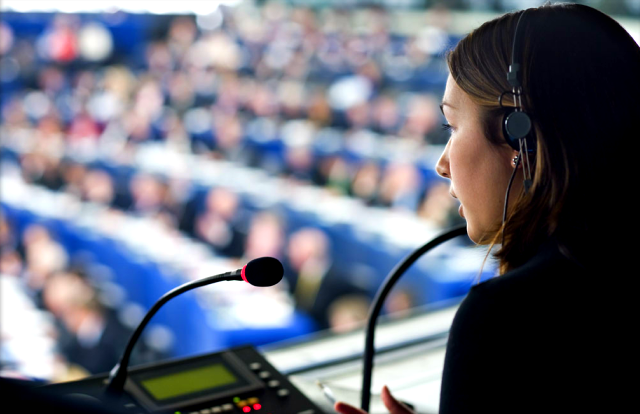Simultaneous interpretation
Simultaneous interpretation (also known as simultaneous or conference translation) is where one or several speakers make a speech in a language and one or two interpreters simultaneously reproduce the same speech or presentation in the language of the listeners. Two interpreters usually work in each booth for the same combination of languages and interpret as a team by alternating every 25 minutes.
There are occasions when this kind of one-way interpretation is not possible because there is more than one passive language (speakers) and more than one active language (interpreters). In these cases relay interpretation is used where the interpreters do not interpret from the original language of the speech but do so from an interpreted language which serves as a link between the original and target language. The language that is used between the original and the target language is called the pivot language.
Simultaneous interpretation is used in congresses, international events, etc.
In order for this interpretation to work correctly it is necessary to have audiovisual equipment made up of audio cabins, wireless receivers, speaker systems, microphones, monitors, and a sound technician who will coordinate the correct operation of each of these components.
There are times when the interpretation is carried out using a system that consists of a radio-frequency transmitter and receivers, without a soundproof cabin. Due to the lightness of the equipment, this is useful in certain circumstances, such as visits to facilities; as it allows delegates and interpreters to move around easily. However, it can never substitute the role of a cabin when dealing with a conference, as there would be sound interference.
Consecutive interpretation
In consecutive interpretation a speaker makes a speech or presentation in a language and an interpreter who is at his/her side reproduces the same speech in the language of the listeners.
The speaker pauses in his speech from time to time so that the interpreter can intervene and reproduce his/her speech in the language of the listeners. The speaking times of the speaker and the interpreter are usually agreed upon before the speech starts, but usually last around 3-5 minutes in speeches and presentations and the time required in negotiations and meetings.
Consecutive interpreting is normally used in bilateral meetings, negotiations, press conferences, interviews, meals, welcome speeches and also in speeches and presentations.
The interpreter must take the necessary notes which will allow him/her to accurately reproduce the speaker’s speech.
Liaison and escort interpretation
In liaison and escort interpretation an interpreter works as a liaison between 2 or more people who speak different languages. The liaison interpreter interprets the contents of the speech of each of the speakers in both directions.
An escort interpreter performs the same functions as the liaison interpreter and also accompanies the client to any site they may need to go.
This may be on business trips, dealings with foreign people in international agencies, sightseeing, etc.
Whispered interpretation
In this type of interpretation the end listener hires an interpreter that interprets only for him/her given that the native language of this listener is different from that of the rest of the listeners in the hall or meeting.
As the name implies, the interpretation that is carried out is simultaneous and in a low voice so as not to disturb the rest of the listeners. This interpretation is not frequently used and is typically for short presentations. It is one way.
It is also known as chuchotage interpretation




